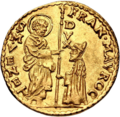Genovino: Difference between revisions
No edit summary |
LukeWiller (talk | contribs) Adding links |
||
| (7 intermediate revisions by 6 users not shown) | |||
| Line 4: | Line 4: | ||
The '''genovino''' was a gold coin used in the [[Republic of Genoa]] from 1252 to 1415. |
The '''genovino''' was a gold coin used in the [[Republic of Genoa]] from 1252 to 1415. |
||
== |
==History== |
||
{{see also|History of coins in Italy}} |
|||
New supplies of gold arrived in Western Europe from [[Sudan]], via caravans from the [[Sahara]], which allowed [[Republic of Florence|Florence]] and Genoa to inaugurate, from the [[13th century]], the minting of these currencies.<ref name=":0">{{Cite book|last=M. Cipolla|first=Carlo|title=Le avventure della lira|publisher=Il Mulino |
New supplies of gold arrived in Western Europe from [[Sudan]], via caravans from the [[Sahara]], which allowed [[Republic of Florence|Florence]] and Genoa to inaugurate, from the [[13th century]], the minting of these currencies.<ref name=":0">{{Cite book|last=M. Cipolla|first=Carlo|title=Le avventure della lira|publisher=Il Mulino|language=it}}</ref> |
||
The ''genovino'' was issued in [[Genoa]] for the first time in 1252, shortly before the Florentine currency, and will be issued until 1415. Next to the ''genovino'' are also struck values |
The ''genovino'' was issued in [[Genoa]] for the first time in 1252, shortly before the Florentine currency, and will be issued until 1415. Next to the ''genovino'' are also struck values equivalent to its eighth ''(ottavino)'' and its quarter (''quartarola).''<ref name=":1">{{Cite book|last=Desimoni|first=Cornelio|title=Tavole Descrittive Delle Monete Della Zecca Di Genova Dal 1139-1814|publisher=Nabu Press|language=it}}</ref> |
||
The coin had a weight of 3.49 |
The coin had a weight of {{cvt|3.49|g|ozt}} of 24 carats (i.e. pure gold) and its diameter is approximately {{cvt|20|mm|in}}. Its [[Obverse and reverse|obverse]] represented the door of a castle, typical of medieval Genoese coins, and around the inscription + IANUA, that means door in [[Latin]] which resonates like the name of the city, and which had already been used in the first currencies.<ref name=":0" /> |
||
After 1339, with [[Simone Boccanegra]], the first [[Doge of Genoa]], the doge's indication began with the inscription: X ''DVX IANVENSIVM PRIMVS''.<ref name=":1" /> |
After 1339, with [[Simone Boccanegra]], the first [[Doge of Genoa]], the doge's indication began with the inscription: X ''DVX IANVENSIVM PRIMVS''.<ref name=":1" /> |
||
==See also== |
|||
*[[History of coins in Italy]] |
|||
== References == |
== References == |
||
| Line 17: | Line 21: | ||
{{Republic of Genoa}} |
{{Republic of Genoa}} |
||
{{Historic Italian currency and coinage}} |
|||
[[Category:Republic of Genoa]] |
[[Category:Republic of Genoa]] |
||
| Line 22: | Line 27: | ||
[[Category:Medieval currencies]] |
[[Category:Medieval currencies]] |
||
[[Category:Coins of Italy]] |
[[Category:Coins of Italy]] |
||
{{Coin-stub}} |
|||
Latest revision as of 21:48, 1 November 2023

The genovino was a gold coin used in the Republic of Genoa from 1252 to 1415.
History[edit]
New supplies of gold arrived in Western Europe from Sudan, via caravans from the Sahara, which allowed Florence and Genoa to inaugurate, from the 13th century, the minting of these currencies.[1]
The genovino was issued in Genoa for the first time in 1252, shortly before the Florentine currency, and will be issued until 1415. Next to the genovino are also struck values equivalent to its eighth (ottavino) and its quarter (quartarola).[2]
The coin had a weight of 3.49 g (0.112 ozt) of 24 carats (i.e. pure gold) and its diameter is approximately 20 mm (0.79 in). Its obverse represented the door of a castle, typical of medieval Genoese coins, and around the inscription + IANUA, that means door in Latin which resonates like the name of the city, and which had already been used in the first currencies.[1]
After 1339, with Simone Boccanegra, the first Doge of Genoa, the doge's indication began with the inscription: X DVX IANVENSIVM PRIMVS.[2]
See also[edit]
References[edit]


